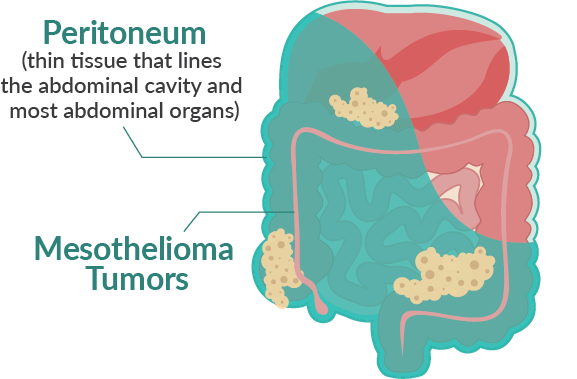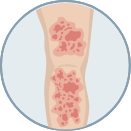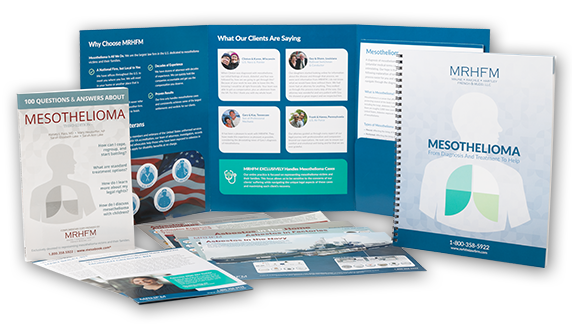Peritoneal Mesothelioma
Accounting for approximately 20% of all mesothelioma cases, peritoneal mesothelioma affects the thin membrane (peritoneum), which protects and supports the organs within the abdominal cavity. The primary cause of peritoneal mesothelioma is the inhaling or ingesting microscopic asbestos fibers, which then become embedded in the peritoneum as the body is trying to pass these fibers naturally. Over time, ranging from 10 years to many decades, these fibers cause cell mutations that damage healthy cells, turn cancerous, and eventually form tumors on the peritoneum.

Peritoneal Mesothelioma Symptoms
Symptoms of malignant peritoneal mesothelioma may take decades to appear after initial asbestos exposure. These symptoms are often similar to common abdominal ailments or discomfort, which makes this cancer difficult to detect and typically do not appear until the cancer has progressed to a more advanced stage.
Individuals with peritoneal mesothelioma may experience:

Ascites

Abdomen Pain or Swelling

Unexplained Weight Loss

Obstruction of Small or Large Intestine

Buildup of Gas

Fever

Anemia

Legs Swelling or Thrombosis

Seizures
Diagnosed with Peritoneal Mesothelioma and need help?
Mesothelioma, it's all we do! Our nurses, advocates, investigators, and legal team can help you seek the medical attention you need and hold those responsible for your diagnosis accountable. Medical help and financial compensation is available. There is no risk for you to speak with our team. We are truly here to help you every step of your battle with peritoneal mesothelioma.
Treatments for Peritoneal Mesothelioma
The treatment plan for treating patients with peritoneal mesothelioma varies depending upon each unique diagnosis. Currently, there is not a cure for peritoneal mesothelioma; however, a combination of these treatment tools may improve life expectancy as well as provide relief from the disease’s symptoms.
-
Immunotherapy - By stimulating the body’s immune system, immunotherapy helps it recognize and attack mesothelioma cells. Its use is growing as new therapies show promising results.
-
Chemotherapy - Widely used across many types of cancer, chemotherapy involves drugs that destroy cancer cells. Certain formulations are specifically tailored to be more effective against mesothelioma.
-
Surgery - When mesothelioma is detected early and hasn’t spread extensively, surgery may be a viable option. It’s often the most direct way to remove large areas of cancerous tissue.
-
Radiation Therapy - This noninvasive approach uses high-energy rays to target and shrink tumors. It’s suitable for various stages of mesothelioma and often helps manage symptoms.
-
Multimodal Therapy - This method combines multiple treatments—like HIPEC—for a comprehensive approach. When available, it often offers the best chance for prolonged survival.
-
Clinical Trials - These trials explore cutting-edge treatments not yet widely available. Participating can give patients early access to potentially groundbreaking therapies and contribute to future medical advances.
HIPEC - The Gold Standard for Treating Peritoneal Mesothelioma
Hyperthermic Intraperitoneal Chemotherapy (HIPEC) with Cytoreductive Surgery (CRS) is the gold standard treatment for patients diagnosed with peritoneal mesothelioma cancer. This procedure removes tumors from the abdomen and treats the affected area with heated chemotherapy. The addition of HIPEC to cytoreductive surgery has improved life expectancy for peritoneal mesothelioma patients.
The Primary Cause of Peritoneal Mesothelioma is Exposure to Asbestos
Common Industries

Military

Mechanics

Shipyards

Construction

Manufacturing

Factories
Various Materials & Products

Flooring, Walls, Insulation

Roof, Siding, Windows

Secondhand

Powder

Plumbing

Pottery & Ceramics
Used for decades in a variety of different industries and products, many people, knowingly or unknowingly, may have been exposed to asbestos in their workplace, home or school. Secondary exposure may be possible from contact with someone exposed to asbestos in which these fibers may have traveled with them on clothing or work equipment.
Help Is Available for Those Diagnosed with Peritoneal Mesothelioma.
Medical Options and Financial Compensation Available - Get Help Today!
By completing the form or calling us at 800.259.9249, we will discuss your situation to determine the medical help options and financial compensation available related to your peritoneal mesothelioma diagnosis. There are top doctors and specialists throughout the United States, as well as over $30 billion is available for those with mesothelioma due to asbestos exposure. Asbestos exposure is the primary cause of mesothelioma.
![]()
Get Medical Help
Not all mesothelioma cases are the same. Diagnosis, treatment plans, and prognosis vary from patient to patient. Our nurses and advocates are ready to assist you every step of your fight with peritoneal mesothelioma.
- Learn about HIPEC and other treatments.
- Get connected to top doctors and mesothelioma specialists.
- Acquire information related to clinical trials.
- Gain support through each stage of mesothelioma cancer.
- Learn about emotional support for you and your loved ones.
![]()
Get Financial Help
Mesothelioma trust funds were created to compensate victims of asbestos exposure. Our investigators, attorneys, and claim specialists can help you get the compensation you deserve from those companies that exposed you to asbestos.
- No Risk. No Bills. No Out-of-Pocket Expenses.
- No Class Action. No Lawsuit Required.
- Money Already Set Aside.
- Tax-Free Compensation.
- Family Rights if Loved One Has Passed.
What can I do with the compensation received from a trust fund claim related to my peritoneal mesothelioma diagnosis?
There are typically no restrictions on how you spend a pertioneal mesothelioma settlement. This money is yours. It is typically tax-free, and typically should not interfere with any other benefits you collect. You can spend it how you please. Many use this money to:
- Pay for medical bills and the cost of treatment.
- Replace lost wages due to diagnosis and caregiving expenses.
- Pay off your home or any debt.
- Invest for the future financial security of your family.
- Modify their homes to improve living conditions.
- Support the everyday cost of living.
- Improve emotional well-being through memory making experiences, therapy, or travel.




